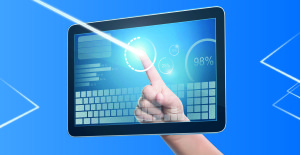Industry 4.0 and Internet of Things (IoT) require new approaches in the Human-Machine-Interface (HMI) and there has been a lot of development in touch display technology during the last years. The artist Salvador Dali once said: “Have no fear of perfection; you’ll never reach it.” Well, this might not be true for this kind of technology for the industrial application. Smart factories need smart interaction abilities: A white paper by Kontron helps to clarify the differences between distinct types of touch and display technologies. Another emphasis is on advancements such as multi-touch HMIs, gesture controlled interfaces and ruggedized systems. The paper also explains the basics of touch technology.
Industry 4.0 fuels demand for sophisticated HMIs

As strategic initiatives like Industry 4.0 have a strong demand for new systems and a lot of effort is put into automating the manufacturing processes further, sophisticated touch technologies are on the rise. Their focus is on connecting formerly stand alone systems like HMIs, giving them the ability to share data and help monitoring factory processes in real time by expanding their computing power. The analysts of Research & Markets forecast the Global Human Machine Interface (HMI) market to grow at a CAGR of 9.98 percent over the period 2014 to 2018. According to the research one of the key factors contributing to this market growth is the growth in industrial automation.
Industrial applications require robust devices
Today two kinds of HMI are most widely used: the capacitive, non-pressure sensitive pads and the resistive touch pads for places like the shop floor area or warehouses where thick work gloves are required. Evolving trends such as gesture control and increased IoT connectivity for real-time data sharing will bring new challenges. The new multi-touch trends include hand operation and gesture control and are anticipated to become increasingly common in production lines. Bringing together advanced techniques like multi-touch and the necessities of dusty or humid environments with a wide range of temperatures is a balance act. Organizations and companies have to decide which device is best suited for their needs on the long run – consulting and proven technologies might be even more important for making the right decision.
New Multi Touch Technologies
The commercial use of tablets and smart phones has pepped industrial devices, too. There is a growing demand for multi-touch screens that provide operational accuracy needed for increased production line control. New HMIs with up to eight touch points allow the operator to perform several tasks at once. Typing with two hands makes it much easier for the user and a user experience that resembles commercial devices results in a shorter learning curve for employees since they are already familiar with the interface. A recent leap move research by HP comes to the conclusion, that people are ready for touch devices and even for gesture control. Of the 6.000 interviewees in Europe, Germany had the best results in recognizing typical touch gestures. Obviously this knowledge doesn’t depend on age, although people between 18 and 24 had the best results – 92.3 per cent knew gestures like scrolling or zooming. Using the common touch and gesture “language” in industrial environments will be a successful concept for future applications.
Do you want to learn more about Kontron’s touch Technologies? Click here!

{{comment.comment}}